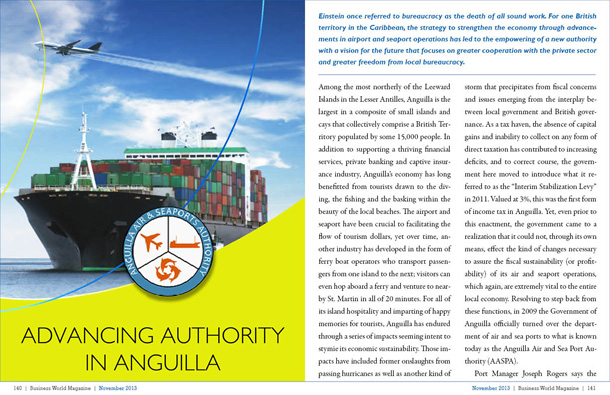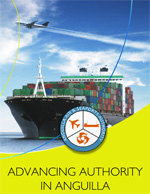
Advancing Authority in Anguilla

Einstein once referred to bureaucracy as the death of all sound work. For one British territory in the Caribbean, the strategy to strengthen the economy through advancements in airport and seaport operations has led to the empowering of a new authority with a vision for the future that focuses on greater cooperation with the private sector and greater freedom from local bureaucracy.
Among the most northerly of the Leeward Islands in the Lesser Antilles, Anguilla is the largest in a composite of small islands and cays that collectively comprise a British Territory populated by some 15,000 people. In addition to supporting a thriving financial services, private banking and captive insurance industry, Anguilla’s economy has long benefitted from tourists drawn to the diving, the fishing and the basking within the beauty of the local beaches. The airport and seaport have been crucial to facilitating the flow of tourism dollars, yet over time, another industry has developed in the form of ferry boat operators who transport passengers from one island to the next; visitors can even hop aboard a ferry and venture to nearby St. Martin in all of 20 minutes. For all of its island hospitality and imparting of happy memories for tourists, Anguilla has endured through a series of impacts seeming intent to stymie its economic sustainability. Those impacts have included former onslaughts from passing hurricanes as well as another kind of storm that precipitates from fiscal concerns and issues emerging from the interplay between local government and British governance. As a tax haven, the absence of capital gains and inability to collect on any form of direct taxation has contributed to increasing deficits, and to correct course, the government here moved to introduce what it referred to as the “Interim Stabilization Levy†in 2011. Valued at 3%, this was the first form of income tax in Anguilla. Yet, even prior to this enactment, the government came to a realization that it could not, through its own means, effect the kind of changes necessary to assure the fiscal sustainability (or profitability) of its air and seaport operations, which again, are extremely vital to the entire local economy. Resolving to step back from these functions, in 2009 the Government of Anguilla officially turned over the department of air and sea ports to what is known today as the Anguilla Air and Sea Port Authority (AASPA).
Port Manager Joseph Rogers says the mandate handed to AASPA was to run the sea port and airport both properly and profitably. Though easier said than done, this move was generally deemed as positive as it would empower the Authority to establish and collect on fees necessary to offset cost of operations, oversee and help facilitate improvements in infrastructure and foster a new era of cooperation with the private sector. As Rogers says, “Sometimes, there’s a lot of red tape people have to go through when dealing with the government … when issues can be address by coming straight to the air and sea port authority… there’s a better flow of business that takes less time and is much more productive.â€
Despite all that was planned in 2009, there have been challenges to the progress of this vision. Earlier this year, a European Union study found than that the government had failed to make good on some of the assurances it had initially given to the Authority. For examples, the land on which the airport and ports are sited had not yet transferred as Land and Survey Department had not surveyed and valued facilities in accordance with the strategy. As opposed to collecting port charges, cruising taxes and embarkation taxes as had been planned; these monies were collected by other government departments such as Customs or “Inland Revenue†officers who, in turn, were to provide that money to the Authority. This created something of a major conflict during the very time when Anguilla was preparing to enhance critical infrastructure. There were plans to establish a new passenger terminal at a site known as Blowing Point, as well as plans to extend the airport landing strip to accommodate larger flights, and more – but all that came to a screeching halt in the wake of sudden fiscal constraints. To explain that requires understanding that almost half of AASPA revenue was anticipated to come from collection of the Embarkation Tax. Yet in 2011, the Government decided it would only hand over 50% of that tax and only on a quarterly basis. The Authority was suddenly denied a crucial element of funding. According to the EU findings, the autonomy initially envisioned had diminished into an ongoing pattern of government micro-management which culminated with a number of the AASPA Board resigning their posts. In fact, the ability to move forward was further hindered by the AASPA’s inability to secure the required government approval of its business plan. For the last two years, the AASPA has been stymied from acting on the very strategy it had devised to generate profits and move forward on the enhancing of infrastructure – but that’s all about to change.
A Positive Outlook
For his part, Rogers is not one inclined to talk about negative politics or problems arising from government interference; he says the AASPA is more focused on finding solutions than finding someone to blame for roadblocks to progress. That EU study (titled “Support to the Anguilla Air and Sea Port Authorityâ€) not only identified challenges, but offered a range of solutions which have since been adopted by AASPA. Measures call for a new management structure to AASPA, the formation of committees of qualified professionals from the airport and the seaport that would manage the interface with the Authority as well as other stakeholder groups, the creation of an association to strengthen the work of local ferryboat operators, and a number of other protocols which include the AASPA’s ability to generate and, more importantly, collect on fees and taxes. What’s more, just this year, the Government finally approved AASPA’s business plan. Rogers says AASPA will finally be able to advance on plans it was never able to implement in the past. He anticipates AASPA will help Anguilla ultimately move forward with extension of the airstrip. He says there are also problems with the existing cargo port which is only 18 feet in depth, but sand sometimes backs-up making it only 16 feet in depth. He anticipates that Anguilla will ultimately see the development of a new deep water harbor in a not so distant future. Other plans call for the development of new passenger terminals. Rogers acknowledges that funding for this infrastructure has yet to be fully secured, but he anticipates that AASPA will be able to forge strategic partnerships and generate revenue significant to the furtherance of these goals. Some of the new fee systems come on line this month, with more to follow next year, and by 2015, Rogers anticipates that AASPA will actually begin generating profits.
Another vital source of support may be realized from the British Government. To put that in perspective, it must be noted that AASPA emerged from former negotiations that occurred between the European Union and Anguilla’s former United Front Government, which was replaced by a new administration following a 2010 national election. Prior to that election, the EU made the development of AASPA a condition for Anguilla’s receiving of EDF funds for port development. During his 2010 campaign, Anguilla’s current Chief Minister Hubert Hughes spoke out against the establishing of the Authority. More recently, he has spoken out against the British Government. During a legislative address, Hughes not only charged Her Majesty’s Government with not only failing to properly support the territory, but suggested it has deliberately, intentionally, devised roadblocks to prevent Anguilla’s advancement; that it was showing more favoritism to other Caribbean Islands, such as Montserrat which recently benefitted from $94 million in infrastructure improvements. Rogers says the problem is not the British. He feels that improving communication, increasing collaboration and making the proper case for the need of support will be helpful to securing greater project funding; and to that end, he expresses optimism that greater support will be achieved in the very coming soon. Likewise, he says that AASPA will be able to advance on strategies to support its own operations and better support Anguilla’s overall economy. Rogers liken the future of AASPA to that so often encountered by boaters in Anguilla, saying, “In time, we’ll be sailing in nice, clear blue waters.â€
For more information, please visit their website at  Anguilla Air and Sea Port Authority
Preferred Vendors of Choice:
- Ashley`s Supermarket
- Current Demands Inc.








